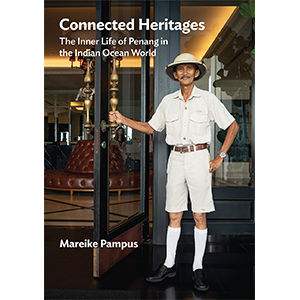The Album of the World Emperor: Cross-Cultural Collecting and the Art of Album-Making in Seventeenth-Century Istanbul
The Album of the World Emperor examines an extraordinary piece of art: an album of paintings, drawings, calligraphy, and European prints compiled for the Ottoman sultan Ahmed I (r. 1603–17) by his courtier Kalender Paşa (d. 1616). In this detailed study of one of the most important works of seventeenth-century Ottoman art, Emine Fetvacı uses the album to explore questions of style, iconography, foreign inspiration, and the very meaning of the visual arts in the Islamic world.
The album’s thirty-two folios feature artworks that range from intricate paper cutouts to the earliest examples of Islamic genre painting, and contents as eclectic as Persian and Persian-influenced calligraphy, studies of men and women of different ethnicities and backgrounds, depictions of popular entertainment and urban life, and European prints depicting Christ on the cross that in turn served as models for apocalyptic Ottoman paintings. Through the album, Fetvacı sheds light on imperial ideals as well as relationships between court life and popular culture, and shows that the boundaries between Ottoman art and the art of Iran and Western Europe were much more porous than has been assumed. Rather than perpetuating the established Ottoman idiom of the sixteenth century, the album shows that this was a time of openness to new models, outside sources, and fresh forms of expression.
Beautifully illustrated and featuring all the folios of the original seventy-page album, The Album of the World Emperor revives a neglected yet significant artwork to demonstrate the distinctive aesthetic innovations of the Ottoman court.
RM302.50
Out of stock
Description
The Album of the World Emperor examines an extraordinary piece of art: an album of paintings, drawings, calligraphy, and European prints compiled for the Ottoman sultan Ahmed I (r. 1603–17) by his courtier Kalender Paşa (d. 1616). In this detailed study of one of the most important works of seventeenth-century Ottoman art, Emine Fetvacı uses the album to explore questions of style, iconography, foreign inspiration, and the very meaning of the visual arts in the Islamic world.
The album’s thirty-two folios feature artworks that range from intricate paper cutouts to the earliest examples of Islamic genre painting, and contents as eclectic as Persian and Persian-influenced calligraphy, studies of men and women of different ethnicities and backgrounds, depictions of popular entertainment and urban life, and European prints depicting Christ on the cross that in turn served as models for apocalyptic Ottoman paintings. Through the album, Fetvacı sheds light on imperial ideals as well as relationships between court life and popular culture, and shows that the boundaries between Ottoman art and the art of Iran and Western Europe were much more porous than has been assumed. Rather than perpetuating the established Ottoman idiom of the sixteenth century, the album shows that this was a time of openness to new models, outside sources, and fresh forms of expression.
Beautifully illustrated and featuring all the folios of the original seventy-page album, The Album of the World Emperor revives a neglected yet significant artwork to demonstrate the distinctive aesthetic innovations of the Ottoman court.
Publisher: Princeton University Press
Hardback
2020
ISBN: 9780691189154

 Potehi Glove Puppet Theatre of Penang
Potehi Glove Puppet Theatre of Penang
 A Girl in Exile
A Girl in Exile
 Dancing on Thin Ice
Dancing on Thin Ice
 Jatuh ke Laut menjadi Pulau, Jilid III: Sajak-sajak Lengkap Muhammad Haji Salleh
Jatuh ke Laut menjadi Pulau, Jilid III: Sajak-sajak Lengkap Muhammad Haji Salleh
 Against Election: The Case for Democracy
Against Election: The Case for Democracy
 Connected Heritages: The Inner Life of Penang in the Indian Ocean World
Connected Heritages: The Inner Life of Penang in the Indian Ocean World
 Monsieur Linh and His Child
Monsieur Linh and His Child





